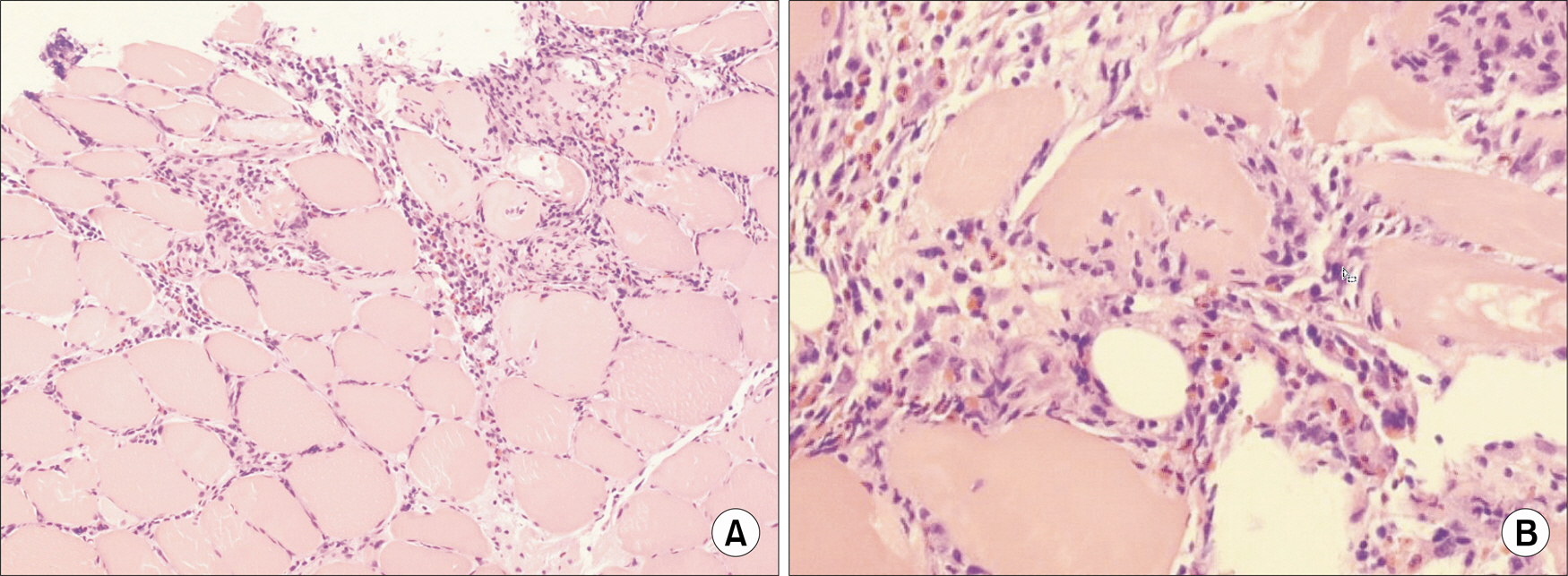J Korean Rheum Assoc.
2007 Jun;14(2):166-170. 10.4078/jkra.2007.14.2.166.
A Case of Hypercapnic Respiratory Failurein a Patient with Eosinophilic Polymyositis
- Affiliations
-
- 1Department of Internal Medicine, Holy Family Hospital,The Catholic University of Korea College of Medicine, Bucheon, Korea. rmin6403@hanmail.net
- 2Department of Radiology, Holy Family Hospital,The Catholic University of Korea College of Medicine, Bucheon, Korea.
- KMID: 1526435
- DOI: http://doi.org/10.4078/jkra.2007.14.2.166
Abstract
- Eosinophilic infiltration into skeletal muscles has been rarely reported in a variety of conditions such as parasite infection, sarcoidosis, rheumatoid arthritis, eosinophilia-myalgia syndrome, and idiopathic hypereosinophilic syndrome. Eosinophilic myositis (EM) is one of idiopathic inflammatory muscle diseases associated with muscle and/or blood eosiophilia. The case of EM complicated with hypercapnic respiratory failure has been extremely rarely reported. A 61-year-old woman was admitted with sudden-onset pain in both calves. She had elevated serum muscle enzymes and peripheral eosinophil count. Findings of electromyography were consistent with inflammatory myopathy. MRI showed diffuse hyperintensity of calf muscles on T2-weighted and enhanced T1 images. Muscle biopsy showed eosinophils' infiltration in the endomysium and perivascular area. During the diagnostic work-up, she presented with hypercapnic respiratory failure. She was successfully treated with mechanical ventilation and high doses of prednisolone. This case suggests EM can cause respiratory failure secondary to respiratory muscle involvement.
MeSH Terms
-
Arthritis, Rheumatoid
Biopsy
Electromyography
Eosinophilia-Myalgia Syndrome
Eosinophils*
Female
Humans
Hypereosinophilic Syndrome
Magnetic Resonance Imaging
Middle Aged
Muscle, Skeletal
Muscles
Myositis
Parasites
Polymyositis*
Prednisolone
Respiration, Artificial
Respiratory Insufficiency
Respiratory Muscles
Sarcoidosis
Prednisolone
Figure
Cited by 1 articles
-
A Case of Eosinophilic Polymyositis in a Patient with IgA Nephropathy
Chang-Min Lee
Korean J Clin Neurophysiol. 2015;17(2):95-97. doi: 10.14253/KJCN.2015.17.2.95.
Reference
-
1). Pickering MC., Walport MJ. Eosinophilic myopathic syndromes. Curr Opin Rheumatol. 1998. 10:504–10.
Article2). Hall FC., Krausz T., Walport MJ. Idiopathic eosinophilic myositis. QJM. 1995. 88:581–6.3). Heffner RR Jr., Armbrustmacher VW., Earle KM. Focal myositis. Cancer. 1977. 40:301–6.
Article4). 윤현정, 김성훈, 김종화, 류완희. A case of eosinophilic perimyositis. 대한내과학회지2001. 65 (Suppl 3): s854-8.5). Khan SY., Hilton-Jones D., Rigby SP. A swollen calf. Lancet. 2005. 365:1662.
Article6). Murray-Leslie CF., Quinnell RC., Powell RJ., Lowe J. Relapsing eosinophilic myositis causing acute muscle compartment syndrome. Br J Rheumatol. 1993. 32:436–7.
Article7). Behari M., Saha P., Dinda A., Prasad K., Ahuia GK. Eosinophilic polymyositis without peripheral eosinophilia. J Assoc Physicians India. 1992. 40:132.8). Kaufman LD., Kephart GM., Seidman RJ., Buhner D., Qyarfordt I., Nassberger L, et al. The spectrum of eosinophilic myositis. Arthritis Rheum. 1993. 36:1014–24.
Article9). Krahn M., Lopez de Munain A., Streichenberger N., Bernard R., Pecheux C., Testard H, et al. CAPN3 mutations in patients with eosinophilic myositis. Ann Neurol. 2006. 59:905–11.10). Kaufman LD., Gleich GJ. The expanding clinical spectrum of multisystem disease associated with eosinophilia. Arch Dermatol. 1997. 133:225–7.
Article11). Murata K., Sugie K., Takamure M., Fujimoto T., Ureno S. Eosinophilic major basic protein and interleukin-5 in eosinophilic myositis. Eur J Neurol. 2003. 10:35–8.
Article12). Dunand M., Lobrinus JA., Spertini O., Kuntzer T. Eosinophilic perimyositis as the presenting feature of a monoclonal T-cell expansion. Muscle Nerve. 2005. 31:646–51.
Article13). Gilchrist JM. Overview of neuromuscular disorders affecting respiratory function. Semin Respir Crit Care Med. 2002. 23:191–200.
Article14). Araya J., Nagai T., Oda H., Ishihara H., Aitani M., Hasegawa K, et al. Polymyositis-induced respiratory failure in the presence of antecedent pleural effusion. Nihon Kokyuki Gakkai Zasshi. 1998. 36:713–6.15). Ivey M., Eichenhorn MS., Glasberg MR., Hyzy RC. Hypercapnic respiratory failure due to L-tryptophaninduced eosinophilic polymyositis. Chest. 1991. 99:756–7.
- Full Text Links
- Actions
-
Cited
- CITED
-
- Close
- Share
- Similar articles
-
- A Case of Eosinophilic Polymyositis in a Patient with IgA Nephropathy
- A Case of Rhabdomyolysis in Eosinophilic Polymyositis
- Two cases of polymyositis presenting with respiratory failure
- Eosinophilic Polymyositis and DRESS (Drug Rash with Eosinophilia and Systemic Symptoms) Syndrome by Antitubercular Agents
- A Case of Eosinophilic Polymyositis Treated with Immunosuppressants




